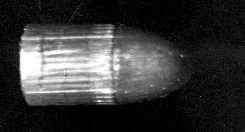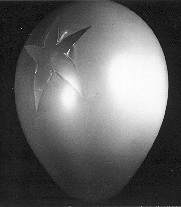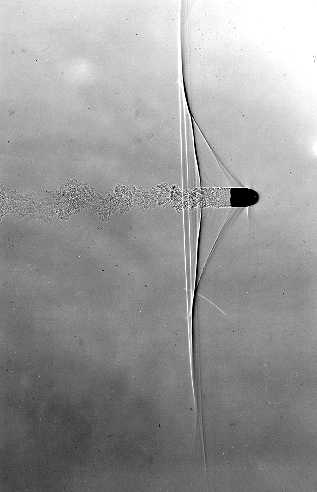
These pictures have no scientific or engineering interest. The only thing interesting about them is that I took them myself. Sort of.

Portrait of a bullet. It's in flight. Really. Trust me.
At MIT in 1962, there was a "freshman seminar" offered by Dr. Harold Edgerton. Basically he turned us loose in the lab to work with his equipment. I think for the most part this was equipment that had been used in previous research projects that were more or less finished. It was a fantastically cool experience. I am not completely sure how educational it was. But at the time, almost anyone nerdy enough to want to go to MIT would have seen Edgerton's famous pictures of milk drops in mid-splash, golf balls flattened to half their diameter at the instant of impact, and so forth, and the opportunity for contact with the famous "Doc" Edgerton was not to be missed.
(Seriously, it was great; one of the things about MIT then and I hope now was that you did get personal contact with people who were doing cool things in science and engineering, and had a playful attitude about what they were doing. For more about "Doc" Edgerton, see http://www.edgerton.org/ )
In the lab, there was a sort of permanent setup consisting of a .22 rifle and, about ten feet away, and a backstop consisting of metal pipe perhaps 4" in diameter and perhaps 2 feet deep, closed at the end, and full of something or other that stopped bullets. The rifle was aimed at the 4"opening. We were given a commercial Microflash unit with a fractional-microsecond flash duration, a microphone, and some electronic stuff that could trigger the flash when the shock wave hit the microphone. We were given some instruction, showed how to sight through the barrel so that the bullet would hit the backstop, told to be careful, and left on our own.
As far as I know, there were never any accidents, though I wonder if a professor and students would be allowed to do this today. (One doesn't think of oneself as having lived in the dark ages, but these were the days when MIT thought it was ethical to conduct biochemical studies on mentally retarded kids who had "volunteered" to be fed small quantities of "harmless" radioactive isotopes...)

This is a balloon in midburst. To show you just how much science and engineering I learned, I can tell you that the five-pointed star is quite characteristic of balloons being burst by bullets, but I can't tell you why. Sorry, not a clue. (I once knew why a piece of chalk usually breaks with a flat fracture surface at 45 degrees to the axis, but since forgotten...) It probably has something to do with tensors.

Pencil being hit by a bullet. The air is full of splinters, and the point has broken from the pencil spinning out from underneath it. (Seeing the vise brings back junior high school days, when a friend of mine and I used to do what we called "torturing inanimate objects." We'd go into the basement, put a glass vacuum tube in a vise and tighten it--S-L-O-W-L-Y--until the glass broke and we could fish out the grid wires and stuff inside... So you can certainly see why the Edgerton seminar appealed to me.)

Shockwave
The Microflash came very close to being one of those idealized things like a frictionless plane. It not only was instantaneous in time, it was a point source and produced lovely, sharp shadow images. You could darken the room, put a piece of film behind the bullet, and get the shadow of bullet, shock wave, turbulence behind it, etc. So I took this photograph, which looks a whole lot like the hundreds of other silhouettes of bullets and shockwaves previously taken by Dr. Edgerton and his associates.
Only this one is mine. And I think that's cool.